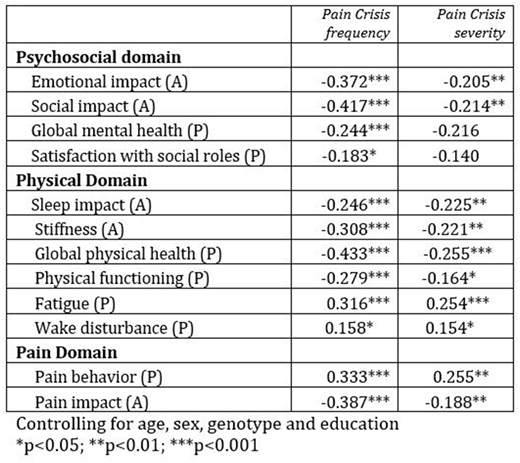Abstract
Background: Patient reported outcomes (PROs) for people with Sickle Cell Disease (SCD) have been shown to be associated with the degree of sickle cell organ system involvement using the Adult Sickle Cell Quality of Life Measurement Information System (ASCQ-Me) medical health checklist [Keller et al]. But since SCD is characterized mainly by vaso-occlusive pain, we explored how and how much various PRO measures correlated with the frequency and severity of painful crises, particularly the annual number of painful crises, which has been related to long-term mortality.
Methods: All included patients had non-missing values (N=200, 52.5% female), age 15 or older and were enrolled in the Start Healing in Patients with Hydroxyurea (SHIP-HU, R18HL112737) randomized controlled trial. Patients completed various ASCQ-Me (A) and Patient Reported Outcomes Measurement Information System (PROMIS, or P) forms to assess PROs in the psychosocial domain (emotional impact, social impact, global mental health and satisfaction with social roles), physical domain (sleep impact, stiffness, global physical health, physical functioning, fatigue and wake disturbance) and pain domain (behavior and impact). Pain attack (crisis) frequency and severity were measured via the ASCQ-Me SCD pain episode frequency and severity short form. The frequency subscale assessed the number of crises in the past year and the timing of the most recent crisis. The severity subscale assessed the pain intensity rating (0-10) during the most recent crisis and the length of that crisis in days. Crises were defined solely by self-report. We tested PRO correlations with crisis frequency and crisis severity, controlling for possible confounding by age, sex, genotype, and education. Analysis used baseline data only.
Results: At baseline, 81.5% of SHIP-HU enrollees were on HU and 87% were SS genotype. The mean age was 29.5 years and 48% had at least some college; 44.2% had a low ASCQ-Me medical health checklist value, 27.9% had a medium value and 27.9% had a high value. See Table for correlations. PRO correlations with crisis frequency and crisis severity were almost always statistically significant, regardless of PRO domain (except for correlations of crisis severity with either global mental health or satisfaction with social roles). Correlations were always higher with crisis frequency than severity. The strongest correlations were -0.43 and -0.42, relating global physical health and social impact, respectively, to crisis frequency.
Conclusions: In SHIP-HU, PROs in the psychosocial, physical and pain domains were statistically correlated with painful crisis frequency and severity, although none were higher than 0.43. More frequent crises and greater crisis severity were correlated with worse psychosocial, physical function and pain behavior and impact, though the correlation was always higher with crisis frequency than with crisis severity. Whether reported painful crisis frequency and severity using PROs are also associated with mortality is not known.
No relevant conflicts of interest to declare.
Author notes
Asterisk with author names denotes non-ASH members.


This feature is available to Subscribers Only
Sign In or Create an Account Close Modal